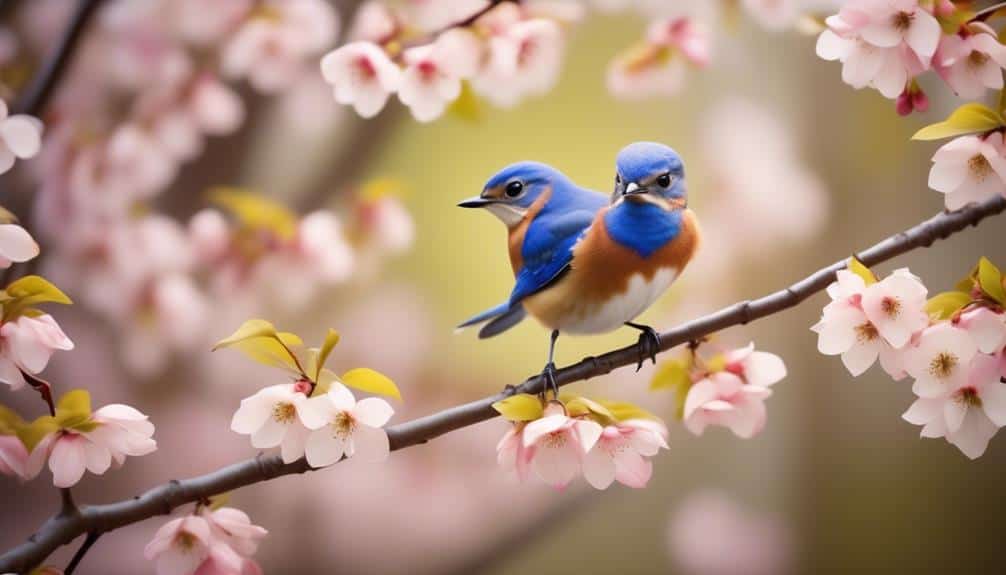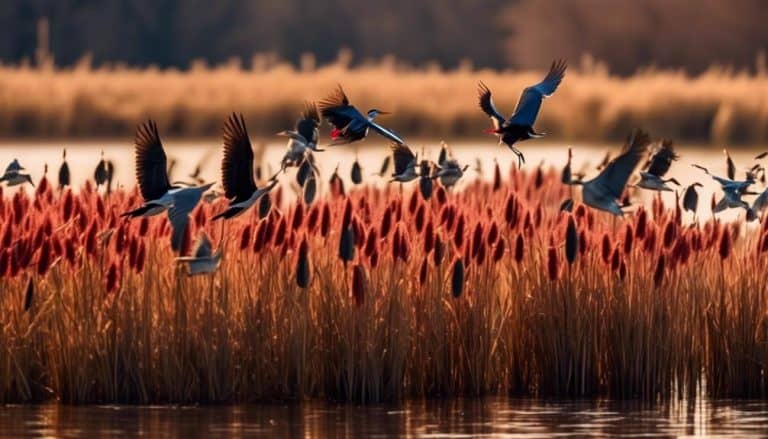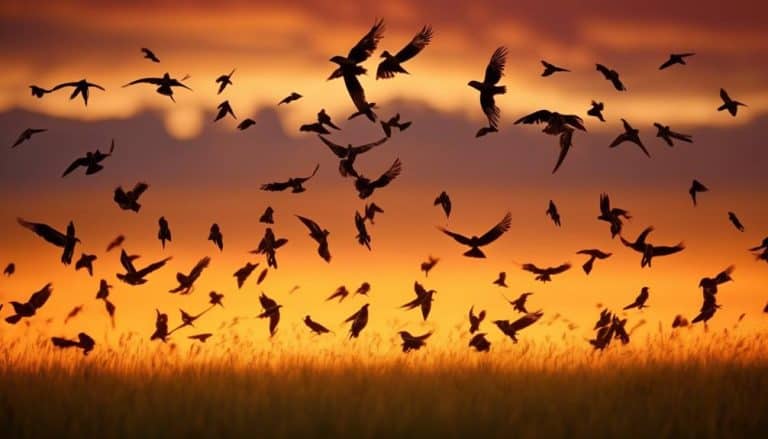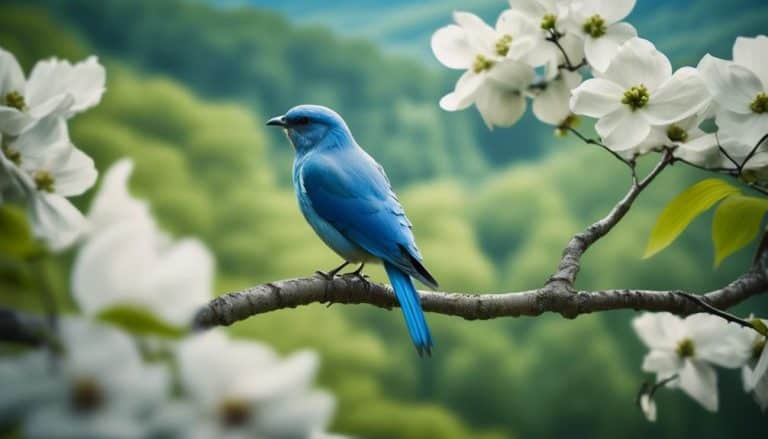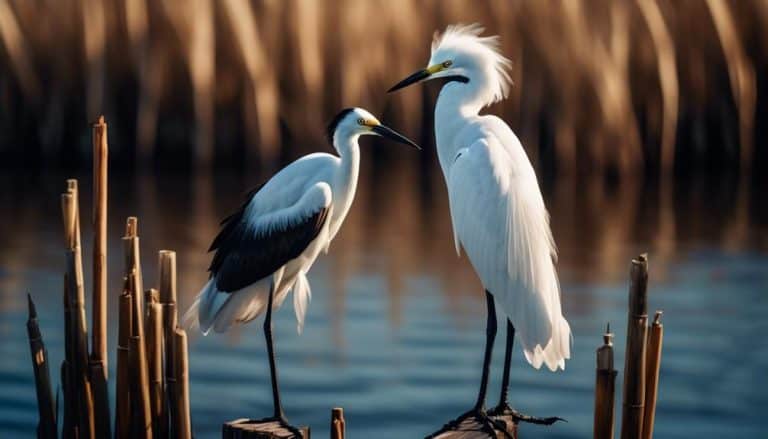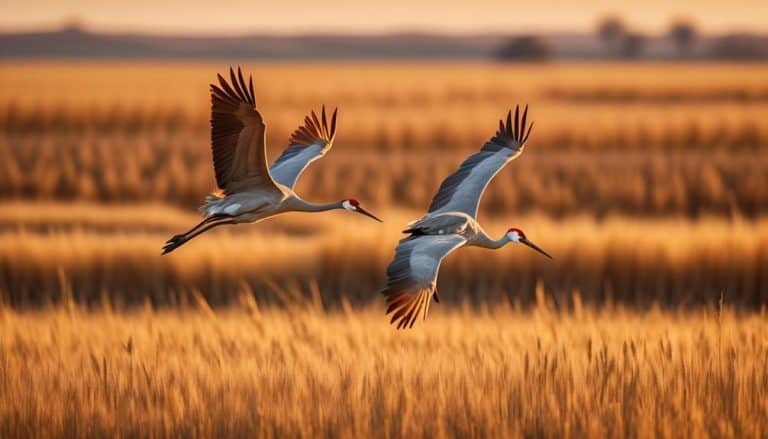Have you ever wondered about the small birds that flit and chirp amidst the lush forests and verdant meadows of Pennsylvania?
These delicate creatures, with their colorful plumage and melodious songs, have captured the attention of bird enthusiasts and casual observers alike.
From the vibrant warblers to the charming finches, and from the common sparrows to the delicate hummingbirds, Pennsylvania is home to a diverse array of small bird species.
Join me as we embark on a journey to discover the hidden world of these tiny avian wonders and unravel the secrets they hold.
Warblers: Colorful Songbirds of Pennsylvania
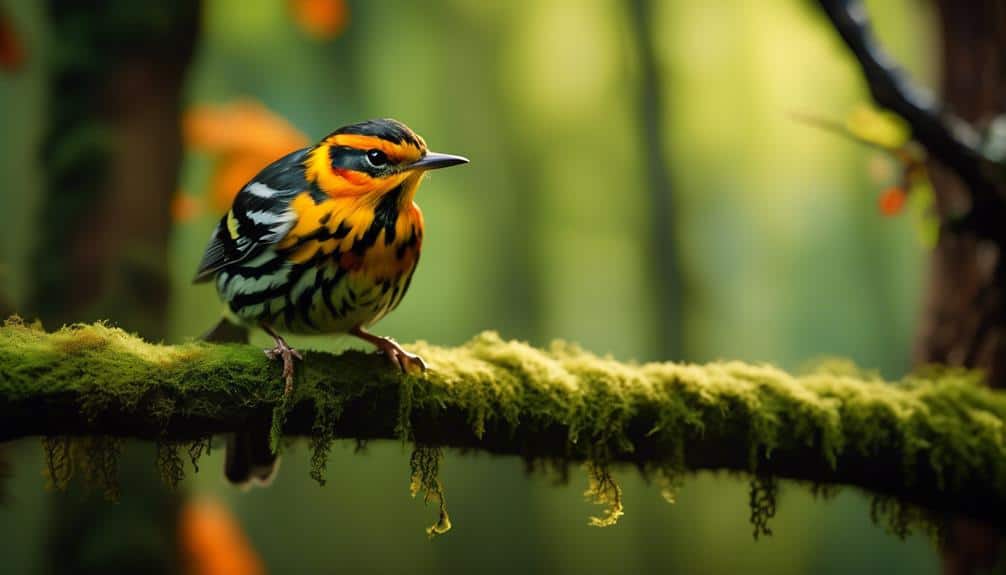
As an avid birdwatcher in Pennsylvania, I'm fascinated by the vibrant and melodious warblers that grace our forests and parks. Warblers are small, colorful songbirds that belong to the family Parulidae. They're known for their striking plumage and melodious songs, making them a delight to observe.
Warblers are migratory birds, with most species spending their winters in Central or South America and returning to Pennsylvania during the breeding season. Their migratory patterns can be quite remarkable, with some warblers traveling thousands of miles each year.
Warblers have a diverse diet, primarily consisting of insects and spiders. During the breeding season, they also consume fruits and nectar, supplementing their diet with these energy-rich sources. Their feeding habits are characterized by active foraging, as they flit from branch to branch, probing leaves and twigs for prey.
To observe warblers in their natural habitat, it's essential to visit areas with a suitable combination of trees, shrubs, and water sources. These birds prefer deciduous forests, as well as wetlands and riparian areas. By understanding their migratory patterns and feeding habits, birdwatchers can increase their chances of encountering these magnificent creatures and appreciating their beauty and charm.
Finches: Charming Feathered Residents
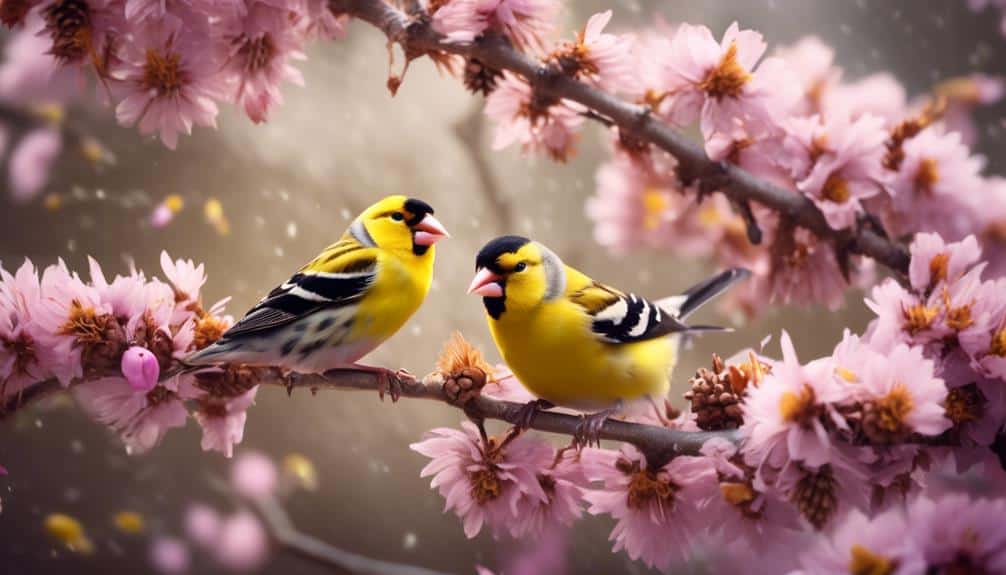
Finches, with their vibrant plumage and delightful songs, are charming feathered residents of Pennsylvania's forests and gardens. These small birds are known for their distinctive beaks, which are perfectly adapted for their preferred diets. Let's delve into the fascinating world of finches and explore their migration patterns and breeding habits.
- Migration patterns: Finches in Pennsylvania exhibit both short-distance and long-distance migration patterns. Some species, like the American Goldfinch, are partial migrants, meaning they move to warmer regions within the state during the winter months. Others, such as the Evening Grosbeak, undertake long-distance migrations, traveling south to escape the harsh Pennsylvania winters.
- Breeding habits: Finches are generally monogamous and form strong pair bonds during the breeding season. They construct intricate nests using a combination of twigs, grass, and other plant materials. Female finches lay a clutch of eggs, typically ranging from 3 to 6 in number, and both parents take turns incubating the eggs. After hatching, the parents diligently feed their young with a diet rich in seeds and insects.
- Courtship displays: During the breeding season, male finches engage in elaborate courtship displays to attract mates. These displays often involve intricate flight patterns, singing, and showing off their colorful plumage. The males' vibrant feathers serve as signals of their genetic quality and fitness, enticing females to choose them as partners.
Finches, with their fascinating migration patterns and intricate breeding habits, continue to captivate bird enthusiasts in Pennsylvania. The beauty and charm they bring to the state's forests and gardens is truly a sight to behold.
Sparrows: Common Small Birds in Pennsylvania
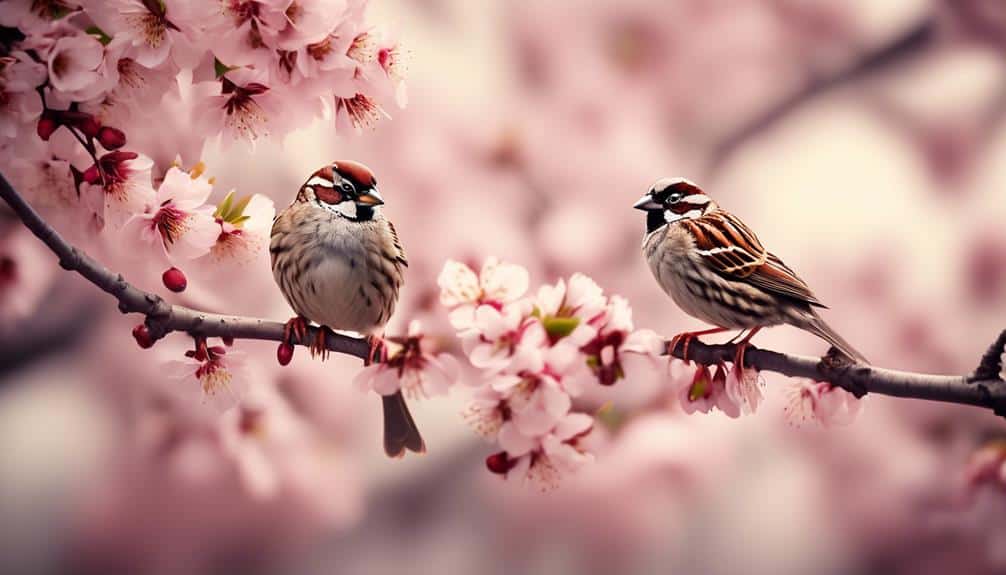
Sparrows, a common species of small birds in Pennsylvania, are known for their adaptability and widespread presence in various habitats across the state. These small birds belong to the family Passeridae and are characterized by their compact bodies, short tails, and stout beaks. Pennsylvania is home to several species of sparrows, each with its own unique features and adaptations.
| Species | Diet and Feeding Habits | Distinguishing Features |
|---|---|---|
| Song Sparrow | Primarily feeds on seeds, insects, and berries. Often forages on the ground or in low vegetation. | Distinctive dark streaks on a buff-colored breast and a prominent central breast spot. |
| White-throated Sparrow | Feeds mainly on seeds and insects. Commonly seen scratching the ground for food. | Easily recognized by its white throat, yellow lores, and striking black and white crown stripes. |
| Chipping Sparrow | Feeds on seeds and insects, particularly fond of grass seeds. Often seen foraging in trees and shrubs. | Identified by its rusty crown, black eye stripe, and crisp chestnut-colored cap. |
| Field Sparrow | Feeds primarily on seeds and insects. Typically found foraging on the ground or in low vegetation. | Distinguished by its plain brown back, clean gray breast, and pink bill. |
These sparrows play an important role in the ecosystem by controlling insect populations and dispersing seeds. Their adaptability and diverse feeding habits allow them to thrive in a variety of habitats, including forests, grasslands, and suburban areas. Whether perched on a branch or hopping through the undergrowth, sparrows add charm and liveliness to Pennsylvania's avian community.
Hummingbirds: Delicate Nectar Lovers
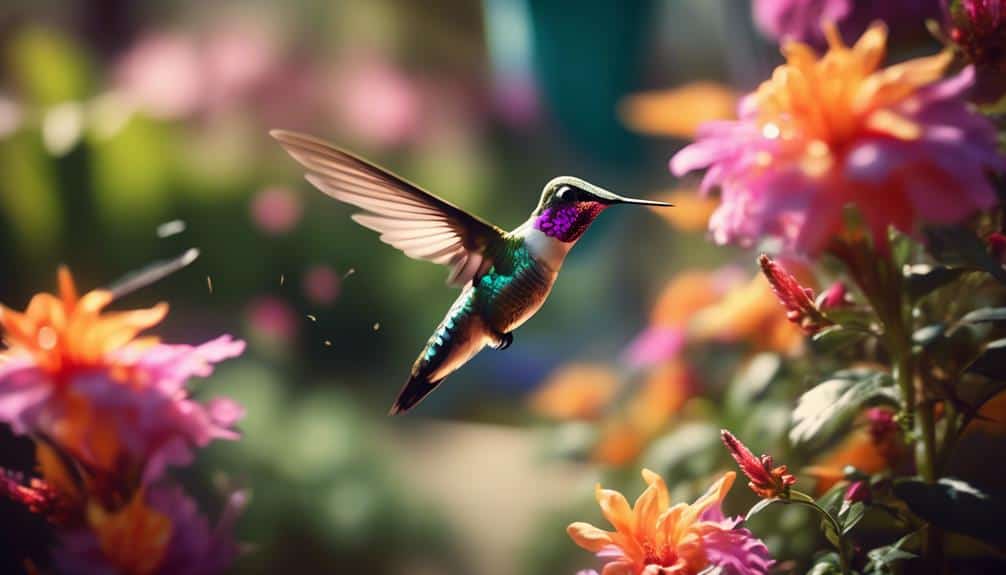
Hummingbirds, known for their delicate nature and love for nectar, are fascinating creatures that captivate observers with their vibrant colors and unique flying abilities. These tiny birds are a delight to watch as they hover in mid-air, their wings beating rapidly, almost invisible to the naked eye.
When it comes to hummingbird migration, these remarkable creatures embark on incredible journeys, traveling long distances to find suitable breeding grounds and food sources.
Here are three ways you can attract hummingbirds to your garden:
- Plant nectar-rich flowers: Hummingbirds are attracted to bright, tubular flowers such as trumpet vine, bee balm, and cardinal flower. These flowers provide the sugary nectar that hummingbirds need to fuel their high-energy lifestyles.
- Hang hummingbird feeders: Fill feeders with a solution of four parts water to one part white sugar. Avoid using red dye, as it may be harmful to the birds. Hang the feeders in a shaded area, away from windows and predators.
- Provide perches and shelter: Hummingbirds need places to rest and hide. Place small branches or thin wires near your nectar sources to create perching spots. You can also plant shrubs or small trees to provide shelter and protection.
Wrens: Tiny Birds With Big Personalities
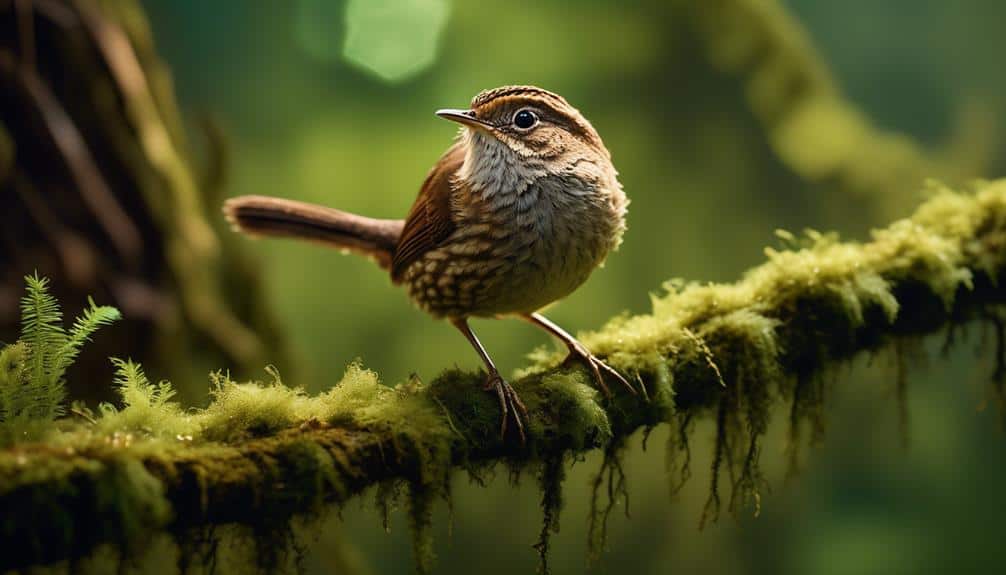
Wrens, despite their small size, possess remarkable personalities that captivate observers with their energetic behaviors and distinctive vocalizations. These tiny birds are known for their lively and active nature, constantly hopping and darting around, as if they have an endless supply of energy. Their behavior is often described as bold and confident, as they fearlessly explore their surroundings and defend their territories with great determination.
One of the most fascinating aspects of wren behavior is their singing. These birds have a rich, melodious song that can be heard throughout the day, especially during the breeding season. Their vocalizations are not only pleasant to the human ear but also serve as a way to communicate with other wrens and establish their territory.
In terms of nesting habits, wrens are known to be resourceful and creative. They build their nests in a variety of locations, including tree cavities, birdhouses, and even old boots or flowerpots. The nests are meticulously constructed using twigs, leaves, and grass, providing a secure and cozy environment for their eggs and young.
To further understand wren behavior and nesting habits, let's take a look at the following table:
| Behavior | Description |
|---|---|
| Singing | Melodious vocalizations used for communication and territorial defense |
| Nesting | Resourceful construction of nests using twigs, leaves, and grass |
| Energetic movements | Constant hopping and darting, displaying bold and confident behavior |
| Territory defense | Fearlessly defending their territory against intruders |
| Exploration | Active and curious exploration of their surroundings |
Frequently Asked Questions
What Is the Average Lifespan of Warblers in Pennsylvania?
The average lifespan of warblers in Pennsylvania is a topic of interest. It is important to consider factors such as habitat, predation, and migration patterns to accurately determine their average lifespan.
How Do Finches Adapt to Different Seasons in Pennsylvania?
Finches in Pennsylvania adapt to different seasons through their mating habits and migration patterns. They adjust their behavior to optimize reproduction and survival, seeking suitable habitats and food sources according to the changing environmental conditions.
Are There Any Endangered Species of Sparrows in Pennsylvania?
Are there any endangered species of sparrows in Pennsylvania? Yes, there are. Conservation efforts for small birds in Pennsylvania are crucial to protect these endangered species and preserve their habitats for future generations.
What Is the Preferred Nectar Source for Hummingbirds in Pennsylvania?
Hummingbirds in Pennsylvania have a preference for certain nectar sources. During their migration patterns, they are attracted to flowers such as trumpet vine, bee balm, and cardinal flower, which provide the necessary nectar for their energy needs.
How Do Wrens Communicate With Each Other?
Wrens, those tiny vocalists, possess a remarkable repertoire of vocalizations. Their melodious songs serve as love letters, enticing mates with their rhythmic cadence. Through these enchanting melodies, wrens communicate their desires and establish their territories.
Conclusion
As I reflect on the small birds of Pennsylvania, I'm in awe of their vibrant colors and enchanting melodies. These delicate creatures flutter among the trees, spreading joy with their cheerful songs.
Each species possesses unique traits, from the finches' charming feathers to the hummingbirds' love for nectar. Despite their small size, these birds fill the air with life and beauty, reminding us of the intricate wonders of nature.
Observing them is an invitation to appreciate the intricate tapestry of life that surrounds us.

